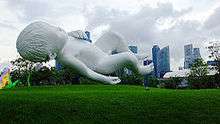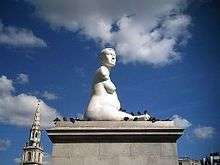Marc Quinn
| Marc Quinn | |
|---|---|
 | |
| Born |
Marc Quinn 8 January 1964 London, England |
| Nationality | British |
| Education | Robinson College, Cambridge |
| Known for | Contemporary Art |
| Notable work | "Self" (1991-), "Garden" (2000), "Peter Hull" (2000), "DNA portrait of Sir John Sulston" (2001), "1+1=3 (Rainbow Sculpture)" (2002), "Alison Lapper Pregnant" (2005), "Siren" (2005), "Evolution" (2005-2008), "Planet" (2008), "All of Nature Flows Through Us" (2008), "Mirage" (2009), "Iris (We share our chemistry with the stars)" (2009-) "Allanah, Buck, Catman, Chelsea, Michael, Pamela & Thomas" (2010), "Toxic Sublime" (2015) |
| Movement | Young British Artists |
| Awards |
2001 - The Royal Academy of Arts Charles Wollaston Award, London 2004 - 4th Plinth Commission for Trafalgar Square, London |
Marc Quinn (born 8 January 1964) is a British sculptor and visual artist. He is a member of the loose group known as the Young British Artists. He is better known for Alison Lapper Pregnant, a sculpture of Alison Lapper which has been installed on the fourth plinth at Trafalgar Square, Self, a sculpture of his head made with his own frozen blood, and Garden (2000).
Quinn has used not only conventional sculpture material, but also blood, ice and faeces; his work sometimes refers to scientific developments. Quinn's oeuvre displays a preoccupation with the mutability of the body and the dualisms that define human life—spiritual and physical, surface and depth, cerebral and sexual.
Personal life
He was married to author Georgia Byng and has two children.[1]
Life and career

Quinn was born in London in 1964. He studied history and the history of art at Robinson College, Cambridge. He worked as an assistant to the sculptor Barry Flanagan. Quinn began to exhibit in the early 1990s. He was the first artist represented by Jay Jopling, and his work was exhibited in Charles Saatchi's Sensation.
Quinn has exhibited exhibitions including Sonsbeek '93, Arnhem (1993), Give and Take, Victoria and Albert Museum, London (2001), Statements 7, 50th Venice Biennale (2003) and Gwangju Biennale (2004).
Solo exhibitions include Tate Gallery, London (1995), Kunstverein Hannover (1999), Fondazione Prada, Milan (2000), Tate Liverpool (2002), Irish Museum of Modern Art, Dublin (2004), Groninger Museum, Groningen (2006) and MACRO, Rome (2006), DHC/ART Fondation pour l’art contemporain, Montréal (2007) and Fondation Beyeler, Basel (2009).
Marc Quinn has created many pieces of art for charity, among them the gold sculpture of Kate Moss at the British Museum and White Elephant, auctioned off for the benefit of The Elephant Family in 2010.[2][3][4][5] Quinn's White Elephant was purchased by art collector and artist Amanda Eliasch.[6][7]
Art practice
Quinn’s sculpture, paintings and drawings often deal with the distanced relationship we have with our bodies, highlighting how the conflict between the "natural" and "cultural" has a grip on the contemporary psyche. In 1999, Quinn began a series of marble sculptures of amputees as a way of re-reading the aspirations of Greek and Roman statuary and their depictions of an idealised whole.
Works
"Self" (ongoing project)
"Self" is a frozen sculpture of the artist's head made from 5 litres of his own blood, taken from his body over a period of five months, the first of which was made in 1991. Described by Quinn as a "frozen moment on lifesupport", the work is carefully maintained in a refrigeration unit, reminding the viewer of the fragility of existence. Quinn makes a new version of Self every five years, each of which documents Quinn’s own aging and physical deterioration.
It was purchased by Charles Saatchi in 1991 for £13,000, who displayed it in the "Sensation" exhibit at the Royal Academy of Arts in 1997. There were rumors that the piece had melted, but Saatchi dispelled those rumors when he exhibited it at his new gallery in London in 2003.[8]
In April 2005 he sold it to Steven A. Cohen, the American hedge-fund manager of Point72 Asset Management (formerly S.A.C.), for $2.8 million.[9] Cohen displayed it at his hedge fund's headquarters in Stamford, Connecticut.[10] The National Portrait Gallery in London acquired Self 2006, purchased through The Art Fund, the Henry Moore Foundation, Terry and Jean de Gunzburg and Project B Contemporary Art, 2009.
Garden (2000)

His next important piece in terms of his public profile was the frozen garden he made for Miuccia Prada in 2000, installed at Fondazione Prada in Milan, Italy. A whole garden full of plants which could never grow together kept in cryogenic suspension. In interview, Quinn explained how this worked, "When working with the frozen material, it’s like doing an experiment—different things come out of it. When you freeze something, it normally dries up. To avoid that, you have to stop the air from getting to the object. You can do this by casing it in silicone".
Portrait of John E. Sulston (2001)
His portrait of John E. Sulston, who won the Nobel prize in 2002 for sequencing the human genome on the Human Genome Project,[11] is in the National Portrait Gallery. It consists of bacteria containing Sulston's DNA in agar jelly. "The portrait was made by our standard methods for DNA cloning", writes Sulston. "My DNA was broken randomly into segments, and treated so that they could be replicated in bacteria. The bacteria containing the DNA segments were spread out on agar jelly in the plate you see in the portrait."[12]
Alison Lapper, The Fourth Plinth (2005–2007)

Quinn has made a series of marble sculptures of people either born with limbs missing or who have had them amputated. This culminated in his 15-ton marble statue of Alison Lapper, a fellow artist born with no arms and severely shortened legs, which was displayed on the fourth plinth in Trafalgar Square, London from September 2005 until October 2007.[13] (The Fourth Plinth is used for rotating displays of sculpture.) In Disability Studies Quarterly, Ann Millett writes, "The work has been highly criticized for capitalizing on the shock value of disability, as well as lauded for its progressive social values. Alison Lapper Pregnant and the controversy surrounding it showcase disability issues at the forefront of current debates in contemporary art".[14]
A large reproduction of the sculpture was used as a central element of the 2012 Summer Paralympics opening ceremony.[15][16]
Siren (2008)

Since 2006, Marc Quinn has made numerous studies of the supermodel Kate Moss. In April 2006, Sphinx, a sculpture of Kate Moss by Quinn was revealed.[17] The sculpture shows Moss in a yoga position with her ankles and arms wrapped behind her ears. This body of work culminated in an exhibition at the Mary Boone Gallery in New York in May 2007. The sculpture is on permanent display in Folketeatret in Oslo, Norway.[18][19]
In August 2008, Quinn unveiled another sculpture of Kate Moss in solid 18-carat gold called Siren, which was exhibited at the British Museum in London. The life-size sculpture was promoted as "the largest gold statue since ancient Egypt".
The Toxic Sublime (2015)
In 2015 Marc Quinn opened an exhibition of new work at White Cube Bermondsey, entitled The Toxic Sublime. It featured new bodies of work that explore the ecological impact of man on nature. ‘The Toxic Sublimes’ are distorted, three dimensional seascapes. Alongside these paintings, a new series of sculptures, cast in stainless steel and white concrete, including one measuring over 7.5 meters long, form part of a body of work titled ‘Frozen Waves’. The sculptures originate from the core of shells, eroded by the endless action of waves.
Recent work
In May 2010, Quinn revealed a series of new sculptures at London's White Cube gallery including The Ecstatic Autogenesis of Pamela based on film actress Pamela Anderson and Chelsea Charms based on pornography model Chelsea Charms.[20]
Quinn's new models include "Catman" (Dennis Avner (who has been tattooed to look like a cat) and transsexual people such as Thomas Beatie, Buck Angel, and Allanah Starr. Quinn's portrait sculpture "Buck & Allanah" depicts the two nude, standing hand in hand, in a pose reminiscent of Adam and Eve. The sculpture of Thomas Beatie depicts him at full-term pregnancy, bowing his head and cradling his abdomen with two hands.
The exhibition also included a new series of flower paintings executed in reversed colour and two large-scale orchid sculptures in white painted bronze, installed in Hoxton Square, opposite the gallery.
In July 2015 Quinn opened a show titled The Toxic Sublime in the White Cube in Bermondsey, London. [21]
Collections
Quinn is represented in several museums across the world, including Tate Modern, in London, National Portrait Gallery, in London, Musée National d'Art Moderne, in Paris, Stedelijk Museum, in Amsterdam, Astrup Fearnley Museum of Modern Art, in Oslo, Berardo Collection Museum, in Lisbon, Musée d'art contemporain de Montréal, Museum of Modern Art, in New York, and Metropolitan Museum of Art, in New York.[22][23]
References
- ↑ "The new Marc Quinn". Times Online, 22 January 2008. Retrieved on 28 February 2008.
- ↑ "The Guardian"
- ↑ http://www.theguardian.com/artanddesign/2008/jun/04/art
- ↑ "Forbes"
- ↑ http://www.forbes.com/fdc/welcome_mjx.shtml
- ↑ "The Sunday Times"
- ↑ http://katieglass.net/2013/07/14/sperm-cakes-surgery-and-socialites/
- ↑ "Blood Sculpture 'Melted'". BBC News. Retrieved 25 June 2012.
- ↑ Colin, Gleadell (10 May 2005). "Saatchi Sells Another Key Work in His Collection". ArtNews.
- ↑ Patrick, Radden Keefe (13 October 2014). "The Empire of Edge". The New Yorker.
- ↑ Wellcome Trust Sanger Institute website (7 October 2002). Retrieved 2 January 2010.
- ↑ Jones, Jonathan. (22 September 2001). John Sulston, Marc Quinn (2001), The Guardian. Retrieved 2 January 2010.
- ↑ BBC report on Alison Lapper Pregnant
- ↑ Millett, Ann. (2008)."Sculpting Body Ideals: Alison Lapper Pregnant and the Public Display of Disability", Disability Studies Quarterly, 28(3). Retrieved 2 January 2010.
- ↑ Gordon Rayner (29 August 2012). "Paralympics 2012: a stirring journey to enlightenment". Daily Telegraph. Retrieved 1 September 2012.
- ↑ "Marc Quinn Alison Lapper Sculpture Thrills Paralympic Spectators". ArtLyst. 30 August 2012. Retrieved 1 September 2012.
- ↑ BBC News. (13 April 2006). 'Model Moss cast in bronze statue'. Retrieved 16 January 2010.
- ↑ "Theartnewspaper"
- ↑ http://theartnewspaper.com/articles/Collector-plans-sculpture-park-to-celebrate-women"%20/20923
- ↑ "Marc Quinn: Just Don't Call It a Freak Show". The Guardian, 10 May 2010.
- ↑ Marc Quinn review - He sells sea shells, Article by Jonathan Jones, The Guardian, 13 July 2015
- ↑ Marc Quinn at Artcyclopedia
- ↑ Marc Quinn at ArtFacts.net
External links
| Wikimedia Commons has media related to Marc Quinn. |